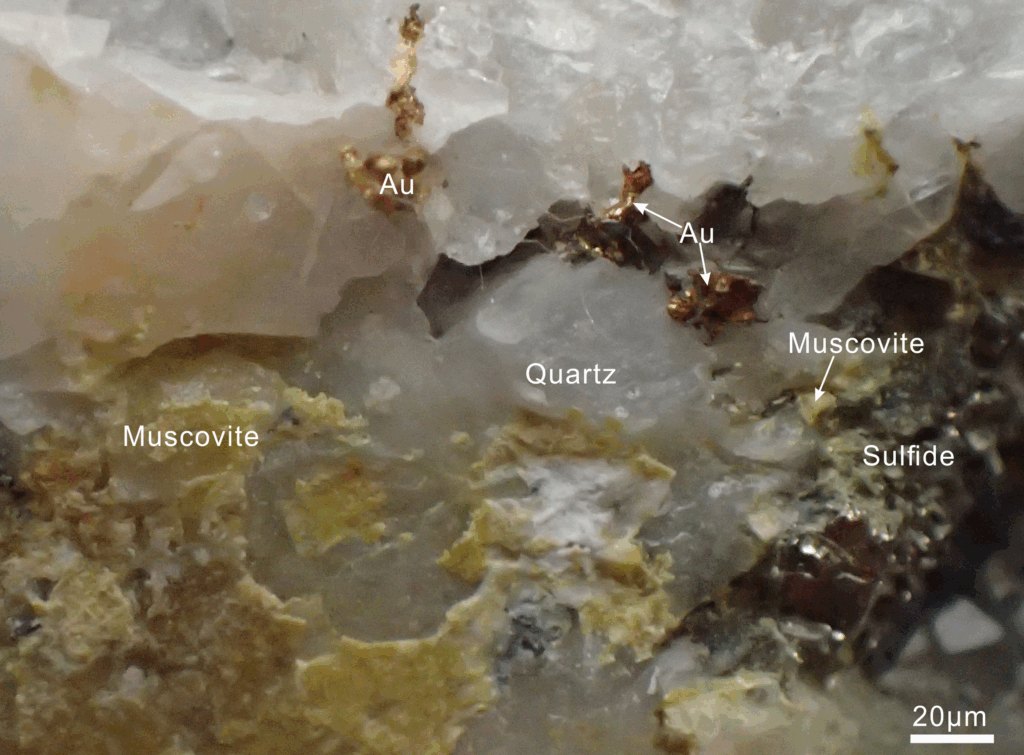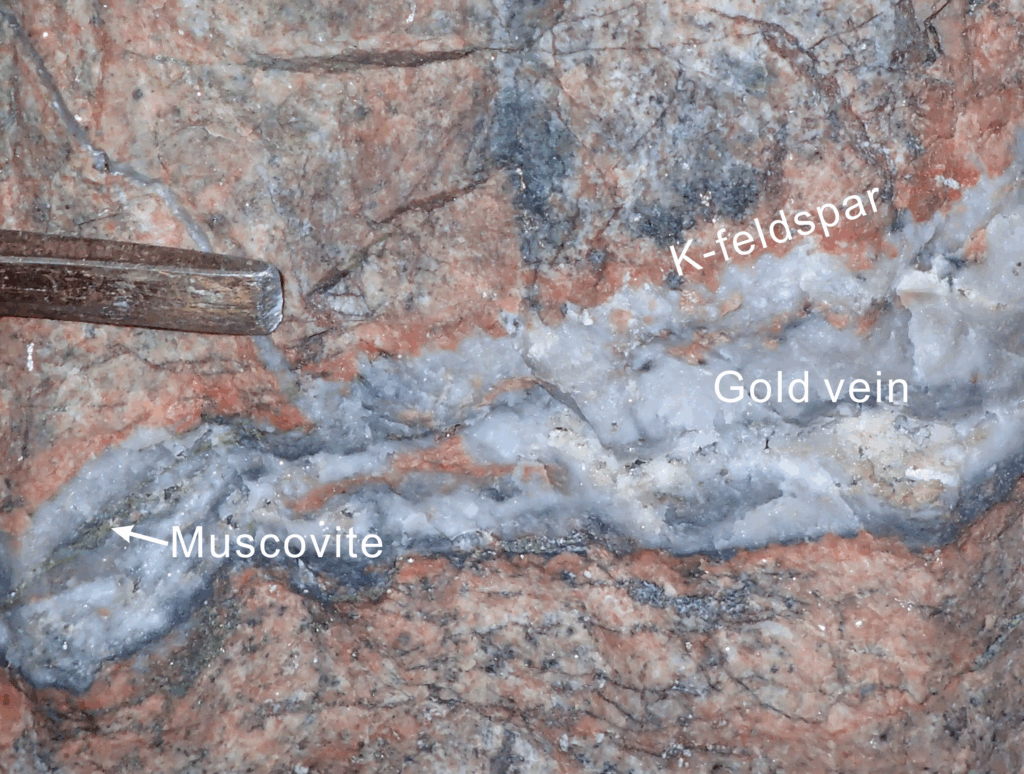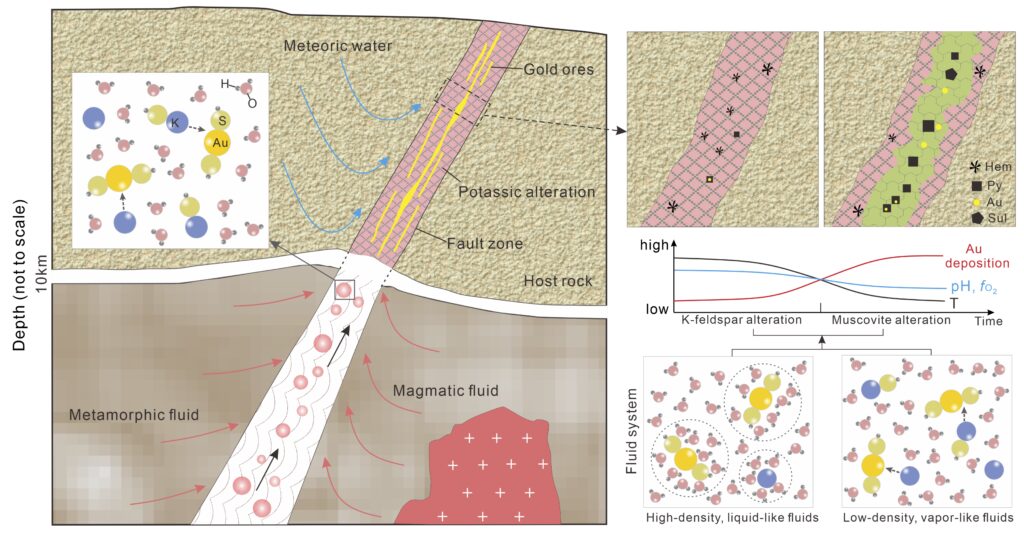Unravelling the Role of Potassium in Lode Gold Mineralisation
We combined AIMD simulation and geochemical modelling to uncover how potassium interacts with gold in lode gold systems. The result is a clearer understanding of when potassic alteration signals gold mineralisation—and when it does not.
Key points
- Using a supercomputer, we were able to simulate how gold is transported in hydrothermal fluids before mineralisation.
- The presence of potassium is a key indicator of lode gold formation.
- Gold explorers could get help in striking gold through a new understanding of how gold forms.

Typical characteristics of potassic alteration and associated gold veins in a lode gold deposit.
Background
Hydrothermal alteration is a complex geological process that can later serve as an indicator of gold deposits for mineral explorers. The process sees hot and metal-rich fluids interact with surrounding rocks, causing chemical and mineralogical changes.
Potassic (K) alteration is a common geological feature of many gold deposits worldwide, particularly lode gold deposits. In these, gold occurs in veins alongside quartz and sulphides within the rock. This alteration is shown up by the presence of potassium-rich minerals, such as K-feldspar and muscovite, with gold accumulating within the alteration zone.
This phenomenon occurs when fluids containing potassium, sulphur and gold interact with surrounding rocks. Such alteration is easily visualised, often showing a light pink colour on a rock surface. It can be used as an indicator of nearby gold mineralisation.
Despite this well-documented relationship, it was previously unknown whether potassium has played a role in the process of gold formation.

Coarse-grained native gold in quartz veins with presence of muscovite and sulfides
Research Challenge
The key question driving this study was: Does potassium actively influence gold transport and deposition in hydrothermal systems, or is its association with gold merely coincidental?
Understanding this relationship is critical for:
- Improving genetic models of lode gold deposits.
- Enhancing exploration strategies targeting potassic alteration zones.
Approach
- Ab initio Molecular Dynamics Simulations – explore metal behaviours under extreme conditions.
- Simulated interactions between gold complexes (Au(HS)₂⁻) and potassium ions (K⁺) under varying temperature and pressure conditions.
- Objective: Assess whether potassium forms strong ion pairs with gold complexes in sulfur-rich fluids.
- Over one million CPU hours on high-performance computing systems.
- Geochemical modelling of Fluid Evolution
- Examined mineralogical transitions from early K-feldspar to later muscovite during potassic alteration.
- Investigated how cooling, pH changes, and oxygen fugacity shifts influence gold precipitation.
Key Findings
- Minimal Role of Potassium in Gold Transport
- Simulations revealed weak ion pairing between K⁺ and Au(HS)₂⁻ in both vapor-rich and liquid-rich fluids.
- Conclusion: Potassium does not significantly contribute to gold transport in hydrothermal systems.
- Fluid Cooling Drives Gold Deposition
- Gold precipitation is primarily controlled by temperature decline, with secondary effects from pH and oxygen fugacity.
- The genetic link between potassic alteration and gold mineralisation stems from fluid evolution, not potassium chemistry.

A schematic model illustrating the genetic relationship between potassic alteration and gold mineralisation in lode gold deposits.
Impact and Significance
This research, published in Geochimica et Cosmochimica Acta (special issue “A Tribute to Terry Seward”), bridges the gap between molecular-scale insights and ore deposit formation models. Reviewers praised its contribution to hydrothermal geochemistry, noting its potential to:
- Refine exploration models for lode gold deposits.
- Provide a theoretical foundation for predictive geochemical tools.
Practical Implications
- Exploration strategies should focus on fluid evolution indicators rather than potassium concentration alone.
- Advanced modelling techniques can be applied to other alteration systems to improve predictive accuracy.
